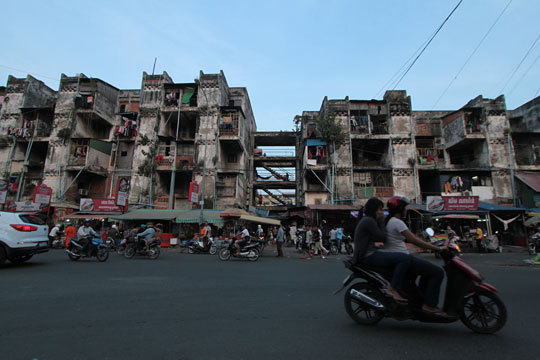About
About the White Building
Under King Sihanouk's vision and leadership, Phnom Penh underwent a tremendous transformation at an unprecedented pace during late 1950s and 60s, with an abundance of newly built public infrastructure, monuments and buildings. Meanwhile, between 1953 and 1970, Phnom Penh's population tripled from 370,000 to one million. [1] This massive upsurge of city residents prompted an urgent need for a housing solution. In an address to Phnom Penh Governor Tep Phan in 1961, King Sihanouk declared:
Finally, our capital must deal with the problem urban population… We must begin the construction of low-cost apartment buildings that can be rented or sold to average and small-income families. This will no doubt take some time and requires progressive planning and investment.[2]
Among the response was the White Building project (originally known as the Municipal Apartments), which was part of the ambitious Bassac River Front cultural complex that lay on reclaimed land along the Bassac River. Designed by Cambodian architect Lu Ban Hap and Russian architect Vladimir Bodiansky, and inaugurated in 1963, the White Building comprised of 468 apartments, and was the first attempt to offer multi-story modern urban lifestyle to lower- and middle-class Cambodians. [3]

Municipal Apartments or the White Building, circa 1963. Courtesy of National Archives of Cambodia and Charles Mayer Collection.
Bassac River Front was overseen by Vann Molyvann, the first Cambodian architect to receive a modern education in France. Vann was immediately appointed Head of Public Works upon his return to Cambodia in 1956, overseeing numerous urban architectural projects. [4] Vann's modern sensibility was very much inspired by Le Corbusier, who was his teacher. The Bassac River Front cultural complex was Vann's first large-scale experiment in applying modern ideas on public housing, and one that was inspired by Le Corbusier's utopian project Ville Radieuse,[5] with Vann adapting the stacking of apartment blocks surrounded by garden, communal spaces, and parking areas.
Among the built structures in Vann's Bassac River Front project were the White Building apartments, the Olympic Village Apartments, the National Bank Apartments, the Exhibition Hall, and the National Theatre. Other buildings that were planned but never realized included a Museum for the Royal Crusade of Independence, a School of Art, Music and Classical Dance, a School of Public Works, a Tourist Office, an Art Gallery and an International Hotel. [6]
After forced evacuation during the 1975-79 regime, some of the former residents including survived artists returned to the neighbourhood and the community grew again as a community of artists. For many in Phnom Penh, the White Building is perceived as an irregular community, cloaked in stigma associated with poverty, drugs, sex work, petty crime, dangerous construction and poor sanitation. However, the White Building is one of the city's most vibrant communities, housing more than 2,500 residents, including classical dancers, master musicians, skilled craftspeople, cultural workers, civil servants, and street vendors.

White Building, 2014. Courtesy of Sok Chanrado.
About the White Building Archive
Over the past decades, many old buildings in Phnom Penh have been transformed or destroyed as part of a recent wave of urban development. However, the White Building is among some historic structures that are holding on against this transition. Keenly aware of its unique history and the insecure future of the community, Sa Sa Art Projects has collaborated with Big Stories Co. to develop an online archive and database which collects living history of this neighbourhood.
The White Building Archive gathers ongoing visual and audio materials produced by art and media students and residents of the White Building. The site also collects selected materials from projects collaboratively created by Cambodian and visiting artists in the neighbourhood. The Archive reflects the contemporary experience of this vibrant community of artists, musicians, community activists and everyday city dwellers who have always lived here.
In addition to this online archive, a physical Archive and Library Room is also accessible inside a studio at the White Building, where the public can also access researches and rare materials about this neighbourhood.
Both the online White Building Archive and the Archive and Library Room offer creative resources of the extraordinary and unique history of the White Building and its community, and propose reflections on the importance that this community plays in the inner city development of Phnom Penh.
[1] Helen Ross and Darryl Collins, Building Cambodia: 'New Khmer Architecture' 1953-1970 (Bangkok: The Key Publisher, 2006), 135.
[2] Ibid, 16.
[3] Ibid, 18-19.
[4] Ibid, 230.
[5] Ly Daravuth and Ingrid Muan, Culture of Independence: An Introduction to Cambodian Arts and Culture in the 1950's and 1960's (Phnom Penh: Reyum, 2001), 11.
[6] Ross and Collins, 16.